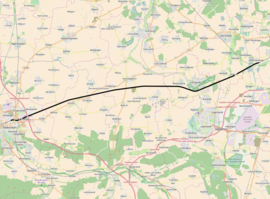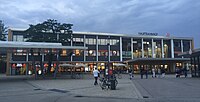Hildesheim – Groß Gleidingen railway line
| Hildesheim – Groß Gleidingen | |||||||||||||||||||||||||||||||||||||||||||||||||||||||||||||||||||||||||||||||||||||||||||||||||
|---|---|---|---|---|---|---|---|---|---|---|---|---|---|---|---|---|---|---|---|---|---|---|---|---|---|---|---|---|---|---|---|---|---|---|---|---|---|---|---|---|---|---|---|---|---|---|---|---|---|---|---|---|---|---|---|---|---|---|---|---|---|---|---|---|---|---|---|---|---|---|---|---|---|---|---|---|---|---|---|---|---|---|---|---|---|---|---|---|---|---|---|---|---|---|---|---|---|
| Route number (DB) : | 1772 | ||||||||||||||||||||||||||||||||||||||||||||||||||||||||||||||||||||||||||||||||||||||||||||||||
| Course book section (DB) : | 313 | ||||||||||||||||||||||||||||||||||||||||||||||||||||||||||||||||||||||||||||||||||||||||||||||||
| Route length: | 34.3 km | ||||||||||||||||||||||||||||||||||||||||||||||||||||||||||||||||||||||||||||||||||||||||||||||||
| Gauge : | 1435 mm ( standard gauge ) | ||||||||||||||||||||||||||||||||||||||||||||||||||||||||||||||||||||||||||||||||||||||||||||||||
| Route class : | D4 | ||||||||||||||||||||||||||||||||||||||||||||||||||||||||||||||||||||||||||||||||||||||||||||||||
| Power system : | 15 kV, 16.7 Hz ~ | ||||||||||||||||||||||||||||||||||||||||||||||||||||||||||||||||||||||||||||||||||||||||||||||||
| Top speed: | 160 km / h | ||||||||||||||||||||||||||||||||||||||||||||||||||||||||||||||||||||||||||||||||||||||||||||||||
| Dual track : | continuous | ||||||||||||||||||||||||||||||||||||||||||||||||||||||||||||||||||||||||||||||||||||||||||||||||
|
|||||||||||||||||||||||||||||||||||||||||||||||||||||||||||||||||||||||||||||||||||||||||||||||||
The Hildesheim – Groß Gleidingen railway is a 34 km long main line in Lower Saxony . The double-track and electrified route runs right through the Braunschweig-Hildesheimer Lößbörde . It was expanded to two tracks in 2012 to improve the compatibility between long-distance and local transport.
history
Hildesheim and Braunschweig had their railway connections as early as the 1840s . A direct connection across the state border between the Kingdom of Hanover and the Duchy of Braunschweig was not desired , at least in Hanover . East-west traffic ran via Lehrte and Kreiensen , Hildesheim was only connected to the Hannöversche Südbahn after Lehrte in the north and with a branch line to Nordstemmen station .
After the annexation of Hanover by Prussia , this changed slowly. The Hanover-Altenbekener Eisenbahn built the Weserbahn and extended it in 1875 with the Hildesheim – Goslar line to the southeast. Hildesheim was thus connected to the east-west traffic. For the direct connection to Braunschweig, the iron ore mining in the northern Harz region first had to increase. On August 16, 1888, the section from Hildesheim to Hoheneggelsen was opened, and on February 1, 1889, the rest of the route to Groß Gleidingen followed, from where the city of Braunschweig could be reached via the Hanover – Braunschweig railway . Four years later, the first German express train, the D 31/32 between Cologne and Berlin, ran over the route, as it was the shortest route in terms of kilometers.
The route remained of secondary importance. It is tangential to Hannover it came up until 1960, the old Brunswick Station , who as head station inhibited through traffic. From 1945 the inner German border blocked most of the traffic from Braunschweig to the east. On May 25, 1976, electrical operation began on the line.
During the construction of the high-speed line Hanover – Würzburg , the Hildesheim loop was also built to connect Hildesheim and Braunschweig to the south. Since 1991 IC trains have been running from Frankfurt via Göttingen , Hildesheim, Braunschweig and Magdeburg to Berlin. These were replaced by ICE in 1993; since 1998 they have been taking the route east of Braunschweig via the Weddeler Loop and the high-speed route Hanover-Berlin . The single-track operation turned out to be prone to delays. The 1992 Federal Transport Infrastructure Plan and its successor from 2003 include an upgraded line from Löhne - Hameln - Hildesheim - Braunschweig, with plans for a continuous two-track upgrade that was completed in 2012.
The section between Hildesheim and Groß Gleidingen was completely closed for renovation between June 20 and September 12, 2002.
business
Long-distance transport
The track is in each case every two hours in the ICE -lines 12 ( Berlin - Braunschweig - Hildesheim - Kassel - Frankfurt (Main) - Mannheim - Basel ) and 13 (Berlin-Brunswick-Hildesheim-Kassel- Frankfurt (Main) south -Frankfurt (Main ) Airport). It is also used as a diversion and relief route for the Hanover – Braunschweig railway line .
Regional traffic
The RE 50 regional express runs every hour between Hildesheim and Braunschweig and is connected to Wolfsburg via the Weddeler Loop . The line, which is part of the Lower Saxony East Electric Network (ENNO), was run by the Metronom Eisenbahngesellschaft under the brand name " enno " for a period of ten years . 24 four-part electric multiple units of the Coradia Continental type from the manufacturer Alstom , which the Zweckverband Greater Braunschweig area provides in its own vehicle pool, are used.
Until December 2015, the regional traffic on the route was carried out by Deutsche Bahn. The offer, which originally ran every two hours, with additional densities during rush hour, had to be cut in December 2006 due to the tight financing situation at the Civil Code . Until December 2015, nine pairs of trains ran Monday to Friday, six on Saturdays and five pairs of trains on Sundays. The offer was still clocked, but the timetable had several gaps in service of three hours. Up to 2012, n-type wagons hauled by class 143 locomotives were used. Between 2012 and 2015 were diesel railcars of DB Class 628 used.
After the expansion of the route, the travel time was reduced from 43 minutes to 33 minutes for the 2012 timetable change. In the 2019/20 timetable year, the journey time is 27 minutes.
Two-track expansion for 160 km / h
In the spring of 2000, the Federal Ministry of Transport examined plans to double-track the Braunschweig - Hameln - Löhne axis as a freight traffic bypass around the Hanover junction. The routes were then to become the main axis for freight traffic in an east-west direction. A decision was expected by 2002. The planning approval decisions for the three sections and a total of 34 km of double-track expansion came into effect on November 14, 2001, December 12, 2001 and February 24, 2002.
At the end of 2007, with the clarification of the financing, a breakthrough for the double-track expansion project was achieved. The federal government should therefore finance 80 million euros for the double-track expansion, the state with 40 million euros the rest of the total. It was planned to expand the line to a maximum speed of 160 km / h instead of the previous 140 km / h. In January 2009 the federal government announced that it would take on 131 million euros of the total investment of 139 million euros. Construction work should start in summer 2009 and be completed by the end of 2012. The state of Lower Saxony and Deutsche Bahn also participated in the financing.
In mid-December 2008, Deutsche Bahn finally put out a tender for the double-track expansion over a length of 34 kilometers. The package comprised an order volume of 100 million euros (net). The financing agreement for the expansion was signed on January 20, 2009. The symbolic groundbreaking ceremony was supposed to take place on January 23, 2009 . However, Deutsche Bahn did not put the work out to tender until mid-July 2009, with the construction contract to be awarded running from November 2009 to the end of December 2012.
The expansion finally started on January 18, 2010. The total costs for the expansion were now given at 140 million euros.
In October 2011 the section between Hildesheim and Hoheneggelsen was put into operation. The ceremonial commissioning of the second track took place on November 5, 2012. The federal government's share of investment was given as 137 million euros. After the completion of the remaining work, double-track operation could commence with the timetable change on December 9, 2012. The elimination of waiting times and the higher route speed reduce travel time by up to ten minutes in local transport and by two minutes in long-distance transport. In addition to the construction of 34 kilometers of track, 19 railway bridges were widened, two road bridges and one railway bridge were replaced and a new railway bridge was built over the Salzgitter branch canal. Three new electronic signal boxes in Bettmar, Hoheneggelsen and Lengede-Broistedt now control the route section.
photos
The new Braunschweig main station, which has been in service since 1960
Web links
Individual evidence
- ↑ Notification of ICE replacement traffic . In: Eisenbahn-Revue International , Issue 8–9 / 2002, ISSN 1421-2811 , p. 355.
- ^ Region Hanover, LNVG, Zweckverband Großraum Braunschweig (Ed.): Metronom is awarded the contract for Elektro-Netz Niedersachsen-Ost (ENNO) . Press release from August 6, 2014. ( Memento of the original from August 8, 2014 in the Internet Archive ) Info: The archive link was inserted automatically and has not yet been checked. Please check the original and archive link according to the instructions and then remove this notice.
- ↑ Metronom Eisenbahngesellschaft mbH : Timetable 2020, 1st edition, valid from December 15, 2019
- ↑ Report south bypass Hanover. In: Eisenbahn-Revue International . Issue 5/2000, ISSN 1421-2811 , p. 194.
- ↑ a b German Bundestag (ed.): Transport investment report for the reporting year 2012 . Informed by the Federal Government (= printed matter . No. 18/580 ). Bundesanzeiger Verlagsgesellschaft mbH, February 18, 2014, ISSN 0722-8333 , p. 47 ( dipbt.bundestag.de [PDF; 66.2 MB ; accessed on February 24, 2014]).
- ↑ District - Second ICE track: start of construction in 2008? In: Hildesheimer Allgemeine Zeitung. November 18, 2007.
- ↑ Hildesheim - ICE expansion: 120 million euro project. In: Hildesheimer Allgemeine Zeitung. December 22, 2007.
- ↑ Federal Ministry of Transport, Building and Urban Development: Tiefensee: Financing of the Hildesheim-Groß Gleidingen railway line secured. Press release from January 21, 2009.
- ^ Deutsche Bahn AG: the line between Hildesheim and Groß Gleidingen will be expanded to two tracks . Press release from January 23, 2009.
- ↑ The bottleneck between Braunschweig and Hildesheim removed. In: NetzNachrichten. No. 4/2012, December 2012, ( PDF file ( Memento of the original from September 28, 2013 in the Internet Archive ) Info: The archive link has been inserted automatically and has not yet been checked. Please check the original and archive link according to the instructions and then remove it Note. , 0.9 MB; ZDB -ID 2548162-9 ), p. 6.
- ^ D-Hannover: Construction work for railway lines. ( Memento of February 13, 2013 in the web archive archive.today ) Document 2008 / S 247-329725 in the Electronic Official Journal of the European Union
- ↑ Finally: Start of construction on the 2nd ICE track in January. In: Hildesheimer Allgemeine Zeitung , December 30, 2008
- ^ D-Hannover: Construction work for railway lines. ( Memento of February 13, 2013 in the web archive archive.today ) Document 195141-2009-EN of July 15, 2009 in the Electronic Official Journal of the European Union.
- ↑ Lower Saxony: Start of construction for Hildesheim - Groß Gleidingen ( Memento from February 27, 2012 in the Internet Archive ) In: Eurailpress , January 20, 2010
- ↑ Start of ICE expansion. In: Die Welt (online edition), January 6, 2010.
- ↑ Heiko Töpfer: Second track further the eye of the needle between Braunschweig and Hildesheim . In: DB ProjektBau (ed.): Infrastructure projects 2012: Building at Deutsche Bahn . Eurailpress, Hamburg 2012, p. 12-17 .
- ↑ Press release 248/2012: 2nd track between Hildesheim – Groß Gleidingen is put into operation. Federal Ministry of Transport, Building and Urban Development, November 5, 2012, archived from the original on February 10, 2013 ; Retrieved November 6, 2012 .
- ↑ Final spurt in the double-track expansion of the line between Hildesheim and Groß Gleidingen. DB Mobility Logistics AG, November 5, 2012, archived from the original on January 21, 2013 ; Retrieved November 8, 2012 .



